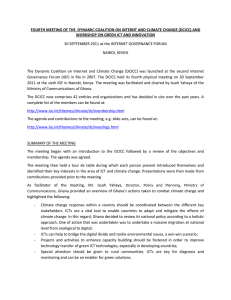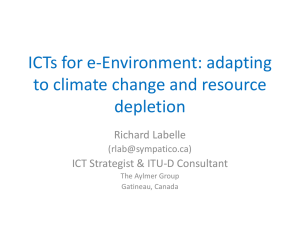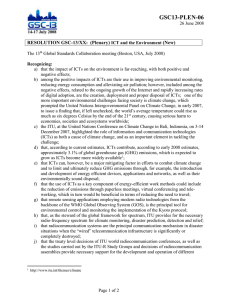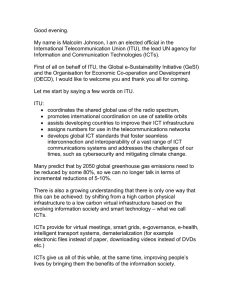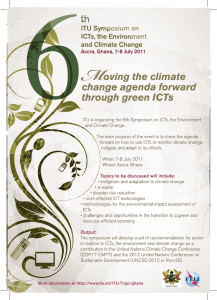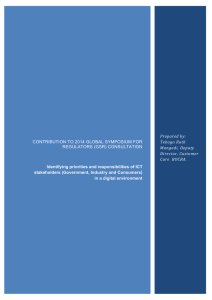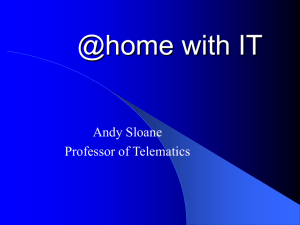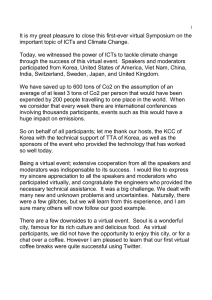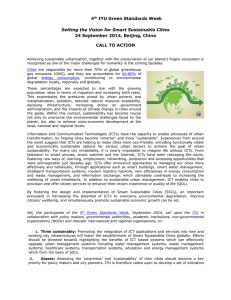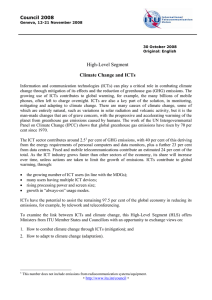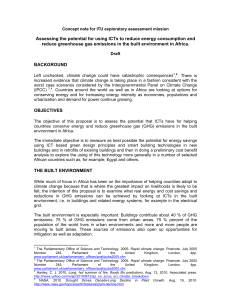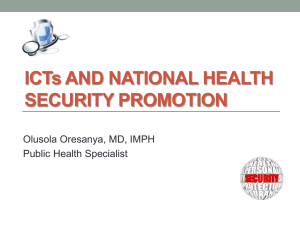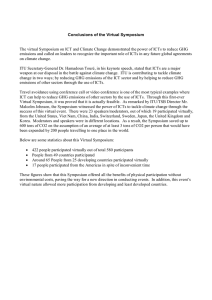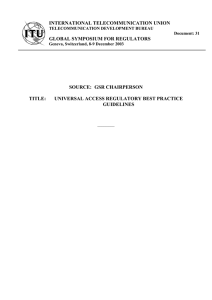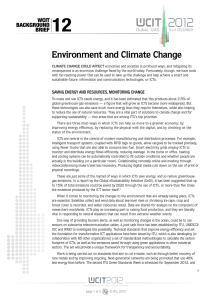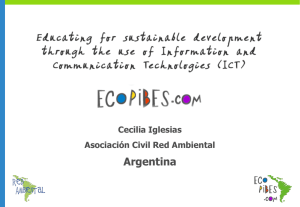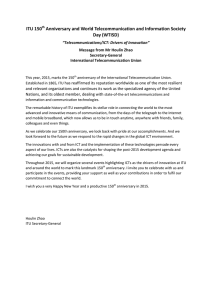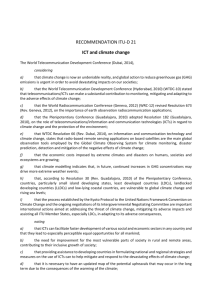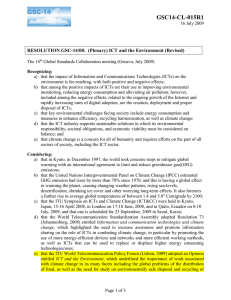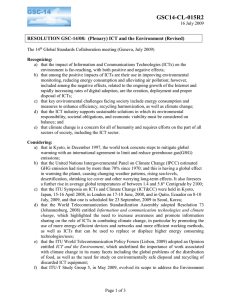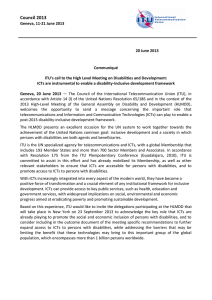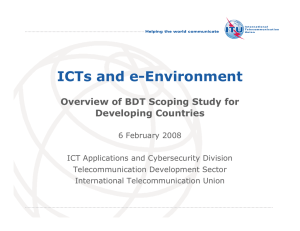ICT Enhancing ICTs in LLDC, Ms. Gisa Fuatai Purcell - UN
advertisement
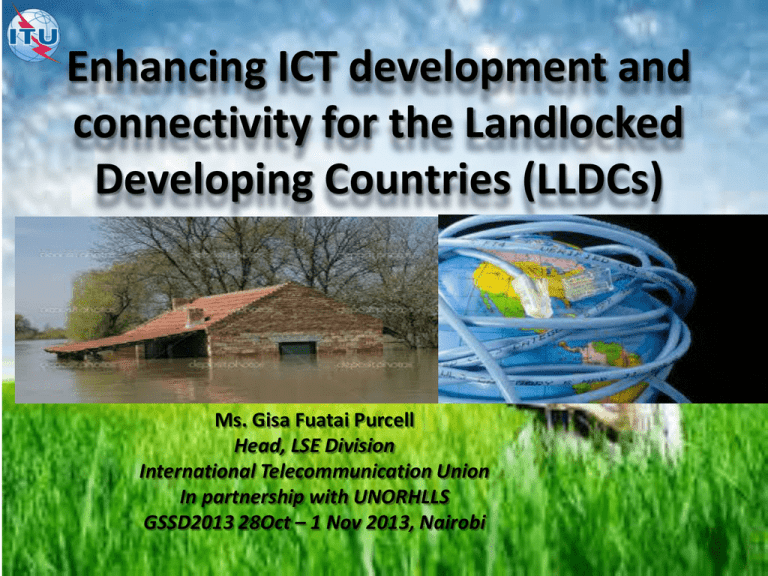
Enhancing ICT development and connectivity for the Landlocked Developing Countries (LLDCs) Ms. Gisa Fuatai Purcell Head, LSE Division International Telecommunication Union In partnership with UNORHLLS GSSD2013 28Oct – 1 Nov 2013, Nairobi Order of Presentation • Brief on Information and Communication Technologies (ICTs) • Land locked countries • Challenges • ICT Development in LLDC –Policies, regulations, legislation • ICTs and Climate Change • ITU and Almaty PoA ICTs Information and Communication Technologies (ICT). • refers to technologies that provide access to information through telecommunication networks – Fibre optic, submarine cables, satellite etc. • focuses on communication technologies delivering not only voice but data including multimedia. • include but not limited to: • i. the Internet – e-applications • ii. Infrastructure - mobile network, VSAT, BGAN • iii. The People Factor – inclusive including disability • Iv. Must be affordable, secure and COMMON ICT SERVICES: • society enjoy a vast array of new communication capabilities. • people communicate and do business in realtime with others anywhere in the world 24/7 – instant messaging (viber) voice over IP (VoIP), and video-conferencing • social networking – Facebook, Twitter etc. allow users to communicate on a regular basis. • Saving Lives – early warning systems – Coordination of relief efforts during disasters ROLE OF ICTS IN CLIMATE CHANGE PREPAREDNESS Vital role – Governments develop disaster management policies, regulation, and legal frameworks development. Implementation of ICT projects and capacity building activities for all COMMUNICATION Communication with people affected is critical. Radio, Television, mobiles – Internet. MITIGATION Early Warning Systems, Establish Evacuation Centers – Advise people. Radio, Mobile ROLE OF ICT IN EMERGENCIES • Reports of a disaster to governments/partners from anywhere in the country • Photos and videos from anywhere in the country to relief organizations • Coordinate assistance and relief work • More importantly; Communicating with people affected. But what is the cost of ICTs? • Recent studies – cost of ICTs are too expensive in developing countries • Bandwidth for one person in Korea may be the total bandwidth available in one developing country • Satellite costs – very high; unaffordable but most useful during disasters • Submarine cables and fibre optics – even higher in developing countries And what of Land Locked Countries? What is the contribution of ITU in implementing the Almaty Plan of Action? ITU ACTIVITIES FOR ALMATY PoA PRIORITY AREAS ACTIVITIES FUNDAMENTAL TRANSIT POLICY ISSUES • ICT Global Policy and Regulatory Framework Harmonization • Human and Institutional Capacity Bulding INFRASTRUCTURE DEVELOPMENT AND MAINTENANCE • Infrastructure Development Projects • Introduction of Sustainable Business Models • National Broadband Plans and Strategies INTERNATIONAL TRADE AND TRADE FACILITATION • E-Business, e-Government, e-Banking, eTrading, PKI for Secure Transactions, Cybersecurity INTERNATIONAL SUPPORT MEASURES • Facilitating Access to technologies and transfer of know how. • Forging Partnerships (Gvts, IGOs, Industry) • Concentrated Assistance, reporting. IMPLEMENTATION AND REVIEW The ITU Works in Partnership • • Mr. Ban Ki-moon, Secretary-General of the United Nations and Dr. H. Touré, Secretary-General of ITU UN agency for ICTs Members: 193 Member States (Governments and regulatory bodies) 700 Private Sector (Sector Members and Associates) 63 Academia ITU works collaborattely with other UN agencies Takes part in other UN agencies conferences Provides input into UNGA various reports Partnership with member states and private sector, civil society, academia Play its role on developing telecommunications and ICTs for all 21
